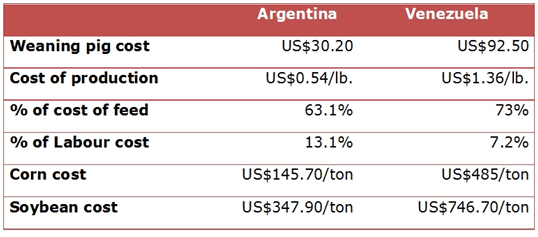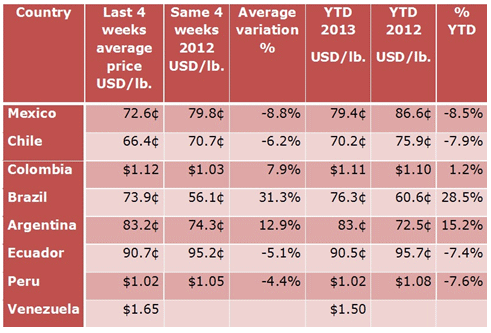



Latin America: Hog Markets
LATIN AMERICA - The pork industry in Latin America is still in its early stages of expansion (with few exceptions), writes Fernando Ortiz, Genesus Ibero-America Business Development.For this particular article, Genesus talks about just nine countries representing Latin America’s pork industry (Argentina, Bolivia, Brazil, Chile, Colombia, Ecuador, Mexico, Peru and Venezuela).
Some of the main problems of swine production in the region are linked to the economies of developing countries, like financing inaccessibility, higher interest rates, etc. Lower pork consumption as consequence of higher prices (compared to chicken and beef), lower GNI, higher retail profit margins (compared to the other 2 meats), almost no promotion and lack of education to consume pork, higher consumption of processed meat and ultimately a lot of taboos about pork consumption (most of them propagated by doctors and dieticians). This is however a problem today but it is definitely a great opportunity for tomorrow. Latin America has an enormous potential for growing pigs because of its vast land area, plenty of good soil and water and excellent climates. Over the last two decades South American grain production has become one of the most important worldwide. In a historical time when most of the pork world is struggling with cost of production because of the higher cost of feed, some South Americans countries are doing okay due to its excellent grain and crop yield.
LA has approximately 3,100,000 technified sows, representing just over 6 per cent of the world swine herd. Brazil, Chile and Mexico are the front runners in swine production performance in LA.
Benchmarking Latin America Pork Production
- P/S/Y - Over the last four years LA has improved its pigs per sow per year (P/S/Y) rate to about 6 per cent. Having 24.8 p/s/y in 2008 compared to 2012 data 26.3 p/s/y. Currently the lowest one is Venezuela with 20 p/s/y and the best ones are Chile and Brazil with around 28 p/s/y.
- Slaughter weight - The average hog market weight in LA trends to increase a little bit. At this time the region shows 246 lb. (110 kg) liveweight average for market hogs which is about 5.7 per cent higher than four years ago. This trend is more noticeable in Mexico than any other country of the region.
- Lb./Sow/Year – LA region has improved on this parameter as well. 6,270 pounds/S/Y is the average in 2012, showing an increase of about 17 per cent over the last four years.
- Pre-weaning mortality is below 9 per cent mainly due to their ability to hire more and cheaper labour, better management and vaccination schedule they are using now in pig production.
One interesting point here is related to feed cost, cost of production and liveweight price. There is a big gap among countries in this region on the economics of pork production. One classic example is comparison between Argentina and Venezuela in terms of costs of production.

The big gap in costs between these two countries is obviously related to political and economic situations. Also Argentina’s advancement in crops is a great attraction for pig producers, getting attention mainly from its neighbors Brazil and Chile who have started to invest heavily in Argentina by buying land, building pig facilities to take advantage of lower cost production. Also some Argentinean beef producers are getting involved in an industry which is more efficient transforming cheaper grain into high value protein.
The following chart shows some of the average last four weeks (March 2013) liveweight prices in LA. Also there are here the last four weeks comparison between 2012 and 2013.

What should be done in order to improve pig production in the region?
- Improvement of economy to increase income per capita
- Discuss with large food retailers about pork profit margins. In most of these countries such margins is normally twice the profit of Europe.
- Changing some habits on eating pork. 70 per cent of pork in LA is consumed as processed meat (salami, hams, pancetta, etc.). These products have an added cost that automatically make it unaffordable for lower income people and are considered of exclusive consumption for higher income classes. Since lower income population is the majority in these countries they are deprived from consuming pork due to its higher price compared to other meats.
- Fresh pork needs to change the way it is showcased. Developing new cuts and offering a more attractive product to the customer including ready-to-cut pork would be of great help in order to put pork consumption at a higher levels.
- Creation of legitimate organizations to certify origin of pork would guarantee more confidence to consumer to buy a healthy and well managed product.
- Fighting old taboos about pork as not a good meat to eat. Educating doctors and dietitians by higher level swine professionals. Letting them know all of the great nutritional facts pork is able to offer to the population. Also show them how modern pig production works in modern times.
- Marketing campaigns lead them by national pork producers’ organizations. Colombia is a god example of this and the country has rose per capita pork consumption by double over the last 5 years.
Summary
Latin America’s countries hold competitiveness and great potential to produce pork. This competitiveness is determined because of their climate, land and water sources available reflected recently in important grain production and lower cost of production (in countries where the grain is produced). Latin America has a huge prospective to increase its pork production and most importantly to raise its domestic consumption and why not, to accept the challenge of a growing food demand with the 7.3 billion population we expect to have in 2015.
| Genesus Global Market Report Prices for the week of March 25, 2013 | ||
|---|---|---|
| Country | Domestic price (own currency) | US dollars (Liveweight a lb) |
| USA (Iowa-Minnesota) | 77.99 USD/lb carcass | 57.71¢ |
| Canada (Ontario) | 1.37 CAD/kg carcass | 49.20¢ |
| Mexico (DF) | 17.53 MXN/kg liveweight | 64.69¢ |
| Brazil (South Region) | 2.86 BRL/kg liveweight | 64.16¢ |
| Russia | 70 RUB/kg liveweight | $1.01 |
| China | 13.37 RMB/kg liveweight | 97.79¢ |
| Spain | 1.377 EUR/kg liveweight | 80.27¢ |
| Viet Nam | 38,500 VND/kg liveweight | 83.52¢ |
| South Korea | 3,060 KRW/kg liveweight | $1.24 |









